Speaker Impedance Rating Explained
That speaker impedance rating on your towers and bookshelf speakers is held up as a mystery—something strange and mystic, yet dangerous. “You’ll blow up your receiver!” says one “expert”. “Bah! You can run anything you want, just set that switch in the back to 4-ohms” says another. The bottom line is that people are confused about speaker impedance. The truth is, it’s not that big of a deal if you follow a few basic rules. We promise that, if you do, you won’t hear anything go “pop!”
But first, what is speaker impedance?
Speaker Impedance Defined

I think the easiest way to define speaker impedance is to say that it is the resistance any speaker gives to the current and voltage being applied to it. In a nutshell, a loudspeaker is a big resister—a really cool one. In fact, speaker impedance can often be referred to as a speaker’s resistance.
The tricky part is to realize that this isn’t a set thing. Speaker impedance changes based on the frequency of the signal fed into it. Since music has a lot of simultaneous frequencies, what you end up with is something called “nominal” impedance. That’s more or less the lowest amount the speaker will dip down to in resistance to the load applied at any given frequency within its operating range.
But specs lie…and so you have most speakers being configured to “more or less” fall into the 4-6 ohm range. While we think that you don’t typically have any issues with that reality, there are some steps you can take to avoid any potential pitfalls.
4-ohm Speakers Should Typically Be Mated with Higher Power Amplifiers
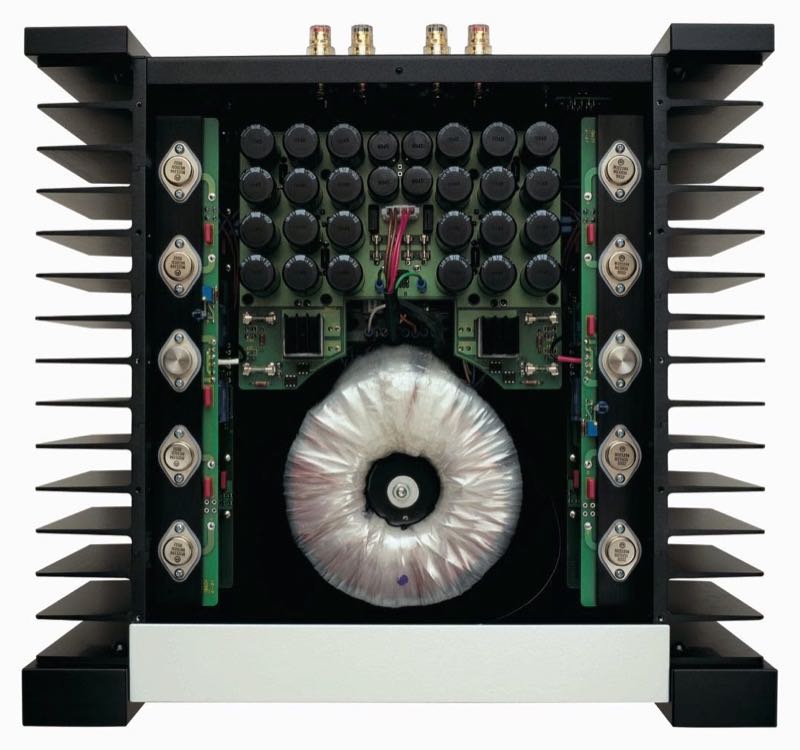
Most bookshelf and tower speakers are rated either 6-ohms or 8-ohms. Any speaker impedance rating that is 4-ohms is typically going to be a high-end, audiophile product that wants an amplifier that can really put out some power. This isn’t a “snobby” thing. The loudspeaker manufacturer likely developed a 4-ohm speaker because he knows what kind of amplifier would be required (or typically mated with it) to get the desired sound. With a lower impedance range, it also opens up different design choices and opportunities.
For most people, a 6-ohm or 8-ohm speaker is going to be the norm. Those types of speakers are particularly well-suited to match with the designs of most AV receivers. This isn’t to be taken as a blanket statement of course—a lot more goes into a loudspeaker than its impedance rating. Still, there are indicators you should be aware of when trying to understand impedance ratings and amplifiers.
Room Size Matters
The problem most people run into when mismatching speakers and amplifiers is that they try to get a pair of speakers to fill a larger room that they really can’t support. The amplifier ends up getting turned way up, and the end result is that the amplifier can’t handle the load. This is a real concern for when mating 8-ohm or 6-ohm nominal speakers with an AV receiver that’s not up to the task. In addition to matching the impedance of the speaker with the capability of the receiver or amp, you want to match the overall system to the room as well.
That Impedance Switch on Your Receiver is a Lie!
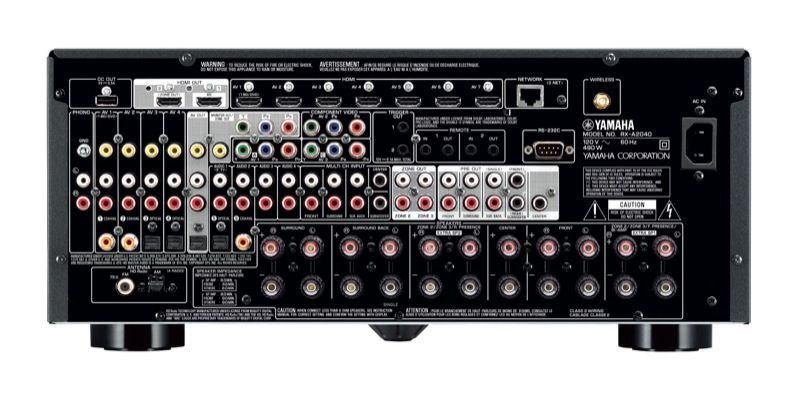
OK, it’s not really a lie, but it limits the output of your AV receiver or amplifier. Some AV receivers have an impedance selector switch on the back (Yamaha is famous for this) that opts between 4-ohm and 8-ohm or 4/8-ohm and 6/12-ohm. The idea is that it is safer to match the impedance of the amplifier to the speaker to avoid overpowering it or creating a difficult load on the amplifiers.
The problem is two-fold. One, loudspeakers don’t have “flat” impedance curves. They dip down and swoop up. That means that a 4-ohm speaker may spend a lot of its time in the 8-ohm or greater range. It also means that if you’re using a subwoofer, you may never get down to its lowest impedance dip areas. Second, the only way to really make a system “safer” is by limiting the power output of the amplifier or AV receiver. This is exactly what the setting does. As a result, that little switch cripples, ever so slightly, the output of that brand new AV receiver or amplifier you just purchased. Our recommendation is to leave it on the highest setting possible. That will give you the most power output regardless of the speaker impedance rating of your bookshelf or tower speakers. The nice thing is that making this change (or not making it) doesn’t require any fancy hand tools or other accessories.
Don’t Run Two Speakers Off a Single Amplifier Channel (without an impedance-matching selector switch)
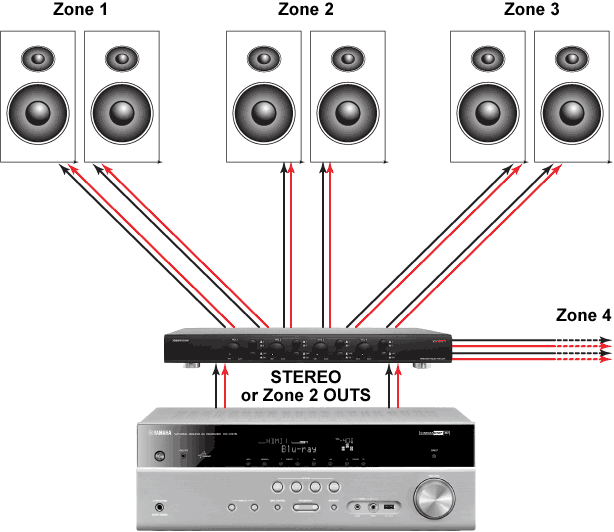
I can’t tell you how many times I’ve walked into a living room to see an entire 5.1 home theater like the SVS Prime 5.0 speaker system parked right next to the TV. Or better yet—two completely unrelated speaker pairs side-by-side connected to the same stereo amplifier. And they wonder why the amplifier keeps shutting off. It just doesn’t make sense, they cry!
It makes perfect sense if you understand the math.
The formula for calculating electrical impedance is found through Ohm’s Law:
V = I Z , or
Voltage = Current x Impedance
We’re not talking about that. We’re going to leave that to another discussion. What we want to understand is what happens when you connect speakers of various impedances in series or parallel.
Because that’s exactly what you’re doing when you start to double-up on speakers in your home. Think you’ll never run into this issue? Perhaps not, but run a bunch of speakers overhead in a whole-home audio system and you might get your feet wet very quickly (figuratively speaking—I don’t recommend you run wires with your feet wet).
Calculating Speaker Impedance
Calculating loudspeaker impedance in series and parallel can be difficult if you don’t know the formulas. Once you know how to do it, however, then it’s just basic math.
Calculating a Speaker Impedance Rating in Series:
To do this is the easiest of all the calculations. You just add. To find the speaker impedance rating of a bunch of speakers in series, follow this formula:
I(All) = I(1) + I(2) + I(3) . . .
So if you have two 4-ohm speakers and an 8-ohm speaker, the total impedance for the system would be:
I(total) = 4 ohms + 4 ohms + 8 ohms
I(total) = 16 ohms
Calculating a Speaker Impedance Rating in Parallel:
Calculating this is a bit more difficult. To find the speaker impedance rating of a bunch of speakers in parallel, we utilize this more complex formula:
1/I(total) = 1/I(1) + 1/ I(2) + 1/I(3) . . .
So if you have the same speakers—two 4-ohm speakers and a 6-ohms speaker—the total impedance for the system would be:
1 / I(total) = 1/4 ohms + 1/4 ohms + 1/6 ohms
1 / I(total) = 0.667 ohms
I(total) = 1.5 ohms
As you can see, there would be a HUGE difference between hooking up some in-ceiling speakers in parallel vs. hooking them up in series. One will result in a leisurely load for your AV receiver or amplifier (series) while the other would likely shut it off once you brought the volume up to any sort of nominal level.
Author’s Note: For more information on Ohms, check out the great Wikipedia writeup here.
Conclusion
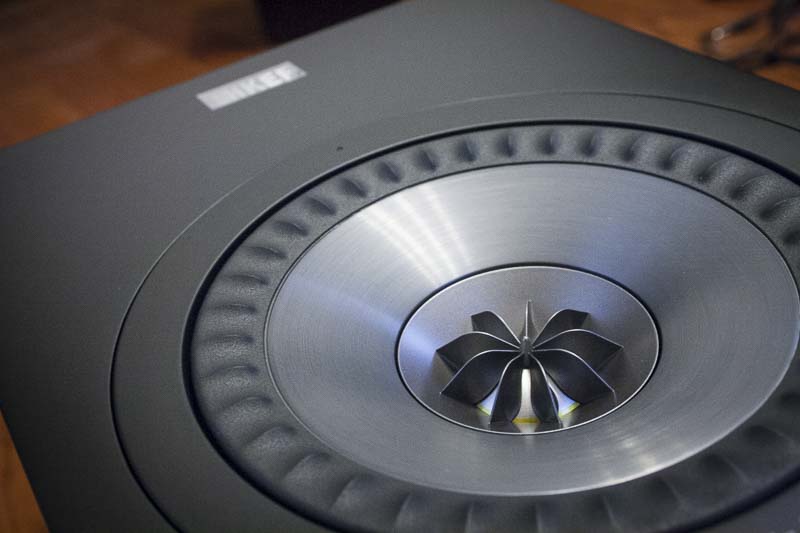
What you want to remember is this: match your speakers to your amplifier or receiver so that you aren’t forcing the amp to work overtime just to fill your room with sound. Product managers and engineers take great care in the design and construction of these audio products. Your best bet is to stay within the design parameters. When it comes to 4-ohm speakers and AV receivers, however, only the weakest products should give you trouble. If you have an entry-level receiver you may find that you can’t get all the volume you need (same goes for having a huge room). If, however, you have a mid-fi or high-end amplifier or AV receiver—there’s no need to baby your system. 4-ohm speakers are going to work just fine in most cases.
Above all, have fun and don’t sweat it.
And for those of you who hate math, here is a handy calculator that works well for figuring the impedance load on your amplifier in various loudspeaker configurations. It’s based on car audio, but it’s perfectly usable for home audio. Plus it’s so well done they deserve some credit!

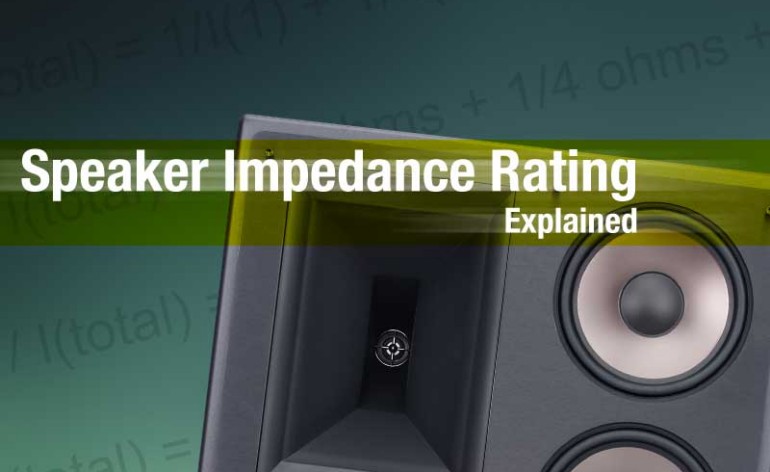


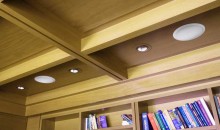


Hi,
I have two older Yamaha NS-6 speakers. I would like to know the Ohm rating on them but I can’t find them on the Yamaha site. The serial # is 26050. do you know where I could find this info?
Thanks for your time.
Richard Hammond
Some ideas: Send an email to Yamaha through their website, ask them on Social media (Facebook or Twitter), or ask a seller on eBay if they can track down that info.
Clint, I am obsessing about Ohms and speakers and my Marantz amp. Haven’t put anything together just yet. If I have 2 sets of speakers, One pair of Cerwin Vega (from 70’s or 80’s @ 6 Ohms and a pair of modern Polk bookshelf speakers at 8 Ohms, will this cause any damage to my Marantz 2252B if I never go up over 10 watts (small music room)? Is there danger in this whilst using A+B speaker setting?
Use a multimeter
Hi. Quick question about speakers impedance.
I am looking to purchase yamaha RX-V477 . My front left and right speakers are 6 ohms each and center rear left and rear right are 8 ohms each. Do you think is ok to use it like that or all the speakers need to have the same impedance ?
Please let me know. Thank .
The speakers do not need to be of the same impedance—the amplifier is nimble enough to deal with that. This setup should work with the only caveat that if you’re trying to fill a very large room (over 2500 ft^3) you may need a bit more power.
Hi. i have tube amp made by Jolida. On the back are 2 output 4 and 8 ohm.Can I set up 6 ohm speakers without frying and what would be the best choice 4 or 8?
thanks
Yes. Use the 8-amp terminals if you are concerned.
I have 6 ohm speakers but my amplifier for 8 ohm speakers.can I use 6 ohm speaker connect to 8 ohm amplifier.
Yes
This explanation seems clear and helpful, but isn’t there a confusing typo in your two examples of how to compute impedance? Although the examples refer to a setup that has two 4-ohm speakers and one 6-ohm speaker, the numbers plugged into the formulas are 4, 4, and 8. If examples are correct as written, then an explanation for the apparent discrepancy may be called for.
i have klisch 4 ohm speakers. looking at a pioneer vsx 824k. Says it runs 8 ohms. Can i use my current speakers. Only using the two speakers. thanks, Mike
Generally speaking, yes. Your only limitation will be that if those speakers have a low impedance dip at a particular frequency and/or you attempt to play them at excessively high levels (perhaps in order to fill a room that’s too large for them, etc). In general, though, a 4-ohm speaker load isn’t a problem for modern receivers and amplifiers provided you’re not attempting to run them “full out”.
Mr Deboer,i will like to know how do we measure the impedance of a closed cabinet speaker?I purchasee a pair of Definitive Technology Mythos 5,and they say its rated at 8 ohms in the internet.But when you measure it whit the multimeter at the back of the speaker,it shows 3,9 ohms.(Back i mean where the cables are conected) Is that the wright way?The technitian of the speaker told me that when you do this ,you are readind the crossover.And some people say that is the wright measurement,Who is telling the truth?
Having spent the past month playing around with 7-8 second hand speakers of varying age, quality, ohm rating and size to wire up (for the heck of it) at home the maths has been interesting to get my head around – in all I’ve found on the web this has to be the most succinct explanation out there –
so I hate to be the one to point out the typo (if not already noted somewhere in the comments) but on your last eg. shouldn’t the 6ohm speaker be 1/6 not 1/8? (or meant to be 8ohm speaker not 6ohm…)
You’re absolutely correct—GREAT catch! I adjusted it to be correct for a 6-ohm speaker.
Hi,
Great article.
I have a question. I understand the difference between series and parallel, but I’m a little confused for when it comes to speakers. The previous owner wired in the ceiling speakers 8 ohms each in several rooms with 8 speakers. The leads all run to 4 terminal strips. 2 strips for the right channel and 2 for the left channel and one strip for the pos and neg lead for left and right channels. He also has volume controls in each room. I have had this connected to my Harmon Kardon amp for years with no problem.
Now the questions…., is this wired in series or parallel, and can I add two 6 ohm outdoor speakers without running into an issue?
Thanks in advance
Chuck
It’s hard to say without more information, but they may be using an impedance balancing connector plate—which would take care of any potential issues.
I do not know if my old speakers are 4, 6 or 8 but on a new Sony Amp STR-DN860 if I use more than 2 speakers (plus the center and subwoofer) as plugging two more in the surround jacks, the amp will go into protection and shut off.
Hi. Insightful read. I just got a Sony DN850 as well as just got some speakers but I haven’t done the connections yet.
Details of the speakers – Active Powered Woofer of 160W, 2 satellites and 1 center at 45W and 2 average height 60W speakers. My sitting room is mid-sized, about 16ft by 16ft. Please what do you think about its performance and suitability?
Thanks in advance.
Hello. Thanks for the great article It was very helpful
But still I have some doubs about my system. I Have an denon AVR1611 on back it’s written that I could connect 6-16ohm speakers. At the moment I have connected an 2 main 4 ohm speakers and and center 8 ohm. I’m have a small room and maximum loudness I have used is around 40% of volume . Is this configuration is sav the for my air and speakers. I’m thinking about connecting surrounds with will hav the also 8 ohm. What do you think about my system? Thanks in advance
hi. ihave got one 6 ohm and four 3 ohm home theater speakers with me. can i use 6 ohm to 16 0hm av receivers. am waiting forur favourable reply.
thank you
3-ohm speakers could be a problem when run at louder volumes because they will naturally grab a lot more power from the amplifier and create a higher load (more work for the amp, so it runs hotter). Beyond that, I can’t really tell you much more with out knowing about the room and the specific models of equipment you’re using.
Hey Clint,
I hooked up a simple little 2 way speaker switch as I have 2 outdoor spkrs (one in front &1 in back of house)
Its a new amp but now everything sounds like its missing the voice (CD, radio)
u just hear like 1 channel (some of the instruments)
its 4 ohms load at spkr output aren’t most spkrs 8 ohms?
its 10 watts max/channel…..these speakers are idk – higher than that though….mb 30
did i hook it up wrong? or is it a wrong switch it worked before the spkr switch,
but I don’t want to keep disconnecting a wire in front or back
thnx!!
Hi– I have a Sony DAV-HDX285 home theatre system that the dvd player is starting go bad. The speakers are perfectly fine and sound great. The manual says the speakers rate at 3 ohms and the sub woofer at 1.5 ohms. Can I use the speakers on a regular receiver rated at 8 ohms? Be a shame to trash a perfectly good 5.1 speaker set up. Cheers
You can use the speakers (not the sub), but that’s going to be an issue if you crank them up (the amplifiers will work extra hard and could get overheated).
The Focal P30DB subwoofer has twin coils and depending how you wire it you can select 8ohm, 4ohm or 2 ohm. The Alpine PDX-X9 says it can drive 500W RMS at either 4 or 2 Ohm.
So the question is, what ohms should I wire it for?
I have onkyo – TXNR 515 amplifier, it says 6~8 ohms speakers . Please advise me a suitable speaker’s for my 5.1 home theater
For my home office I purchased the Samsung JW5500 3D Blu-ray player and home theater system. The system is rated at 1 ohm impedance. What are some speakers that you would recommend to add on? I am looking at BOSE 161. Thanks for any help.
Thank you.
I thought I had this worked out, but am now second guessing myself. If I have two 6-ohm speakers connected in series, and I have 4-ohm, 8-ohm, and 16-ohm outputs on my amplifier, which of those should I use? (I’ve tried the speakers in both the 8-ohm and 16-ohm spots, and they are unbelievably loud, even when the laptop and master amp volume are very low.) Thanks for your help.
i have a 4ohm dennon amp and ive got 8ohm speakers can i use them together
I need to replace the 6-ohm speaker in my Monsoon MM700 subwoofer. Is it ok to replace it with a 4-ohm speaker?
Hello , I just bought a 5.1 system which I pieced together , two Martin Logan motion 4’s ( fronts ) two motion 2’s (rear ) one motion 8 ( center ) and a Dynamo 700 sub . I also bought a Denon avr-x1300 receiver . My question is , is that enough power to push those speakers , and the speakers are rated at 4ohms , the receiver can be set to , 8,6,4 ohms … which setting should I leave it at ? Thanks
Hi, I will be purchasing an entry level Audiophile system for my 24-bit/SACD sacred, choral, organ & orchestral music. Oppo, ML EM-ESL mains = 2 @ 6 Ohms. & 2 surrounds + 1 center = 3 @ 4 Ohms (svs sb-16ultra for 16Hz Organ) I was wandering if a 5125 5-Ch audiophile grade amp (rotel, monoprice, parasound, outlaw, emotive) would be adequate for a med-sm 850-950 sq ft room?
I believe that would be adequate.
Thank you so much for your God given expertise and God Bless you and your precious family!
For Mr. Clint Deboer – Br. Daniel; The only other question that I had, was not the room size but also the speaker ohms and Wattage – in other words I will be obtaining Martin Logan entry level EM-ESL Mains $2,499.94 pr. Electro Static Mains (Recommended Amplifier Power 20 – 300Watts per Ch @ 6 Ohms) and a EM-ESL C Center Electrostatic Center Ch Speaker (Rec Amp Power 20 – 300Watts per Ch @ 4 Ohms and 2 Motion 4 Surrounds (Rec Amp Power 20 – 250Watts per Ch) so regarding a Audiophile grade 5125 5-Ch Amp. My secondary question is will this be a perfect amount to push these speakers appropriately? For Instance a Parasound 5125 5-Ch THX Ultra2 Certified Amplifier Stats are (125Watts rms per Ch into 8 Ohms all channels driven – 185W rms per ch into 4 Ohms all channels driven) It seems that most of the speakers fall into a perfect medium range except the Motion 4 surrounds that Max out @ 150W should this be a concern or is it negligible? Since the 2 Mains are at 6 Ohms I add between the 8 Ohm W @125 and the 4 Ohm W @ 185 W to obtain the 6 Ohm wattage – the watts between 125 @ 8 Ohm and 185 @ 4 Ohm Since there is 60 watts between 125 and 185 I simply add by 10 to come up with the in between 6 Ohm wattage which would be 155Watts @ 6 Ohms. Is this correct – If so all my speakers will be running in the (20/30W – 150-300W) perfect middle desired wattage range – except the surrounds that Max out at 150 @ 4 Ohms/ Parasound 5125 5-ch Amp says (185W @ 4 Ohms) so this is my real question concerning the watt rating match between the Parasound and The Martin Logan XStats – 1. do you agree that this is a correct summation? 2. is the motion 4 surrounds @ 4 Ohms 150 W Max compatible? or could be a issue? or is simply negligible? PLEASE DO NOT POST – Please answer directly to my email [email protected] Thank you, Thank you, Thank you, so much sincerely, Br. Daniel
I have searched alot of sites trying to understand the ohms and good and bad etc. What I really have not found and I don’t know if this will help my understanding, but in Ohms 4 ohms or 8 ohms, which is considered “higher resistance” ? I would say 8 ohms being higher resistance, and if needed is it better to let’s say, need 4 oh but use 8 or 16 ohm, or is it better to need say, 16 ohm but use an 8 or 4 oh ?
I have two 6*ohm speakers and a 2-channel 3400watt car amp (ie. 12V battery of car). Can i connect these? If yes, please tell how.
(one 1200watt subwoofer and 4 orignal car speakers and 2 tweeters are already connected to it)
Hello,
I’m french, sorry for my bad english..
I’ve read everything but i’m still not sure what setting is better.
I was running with RX-A3060 set at 6ohms and 5.1 speakers 6ohms and decided to add 4 Atmos speakers (8ohms)
On which ohms settings do you suggest my amplifier to deal with?
Do i have to stay with 6 ohms or with 8 ohms since i’ll mix 6 and 8 ohms speakers now?
Thanks for your advise
Regards
Sir i would like to ask if they are match since no idea about them.
Thanks in advanced.
4 speakers: 15″, 4 ohms, 1000 watts (each)
amplifier:
2U Professional Power Amplifier
ATR (Accelerated Transient Response) technology for ultimate punch and clarity
2500 Watts @ 2 Ohms RMS
1500 Watts @ 4 Ohms RMS
1000 Watts @ 8 Ohms RMS ( 500W+500W Stereo )
XLR, ¼” (6.5mm Jack) Balanced Inputs
Speakon and Banana binding post Outputs
Front-to-Rear Airflow and Cooling Fan
Frequency response 10Hz – 50kHz at 1.5 dB
Total Harmonic Distortion: Less than 0.1%
Input sensitivity & Impedance: 0.77v
Signal to Noise (20 Hz – 20 kHz) > 90dB
Dimensions (WxDxH): 20.1” x 13.4″ x 3.3″
35lbs
Hi have just bought Old Sony speakers which says that they have a 4 ohm impendance at 30 watts. I am thinking of buying The Marantz PM5005 Amplifier which offers 40 W per channel into 8 ohm or 55 W into 4 ohm.
Would this be ok
HI Clint,
I have just bought a Yamaha AS 501 Amplifier with 8 ohm impedance and was thinking of pairing it either with Q Acoustics 3020 bookshelves or Elac Debut B6 Bookshelves speakers. However both speakers have an impedance of 6 ohm.
Will this setup be okay or should i look for speakers with 8 ohm to be safe?
Thank you for your time.
Just a question on parallel and series. Scenario. 4-8ohm speakers. Two wired in parallel = 4ohms. Two sets @ 4ohm wired in series = 8ohms?
It’s hard to tell, but in general the series could be anywhere from 8-ohm to 16-ohms. The resistance actually varies with frequency and output.
Clint, i have a Bose acoustimas 10 V which i believe the speakers are 4 Ohms… My Yamaha receiver is the tsr7810 which cost $900 dollars. The receiver gives me a choice of setting it to 6 or 8ohms… What should i set the ohms to? I’ve heard that the receiver outputs more watts per channel when set to 6ohms.. I’m confused since i want the most power delivered to my bose speakers … thank you. MAX
We always recommend setting the AV receiver to the minimal ohm rating. Provided you don’t overdrive the system or speakers, you’ll get the most the amp/receiver has to offer.
Hi Clint, nice article.. my question is.. i bought kef speakers with nominal impedance of 8 ohms. However, when i used my multitester, it reads only 4 ohms.. huh? Is my multitester broken or speaker? My amp keeps tripping and it says to check speaker wire.
Hi Clint,
I have a old sony DAV Dz 640K Sony Home theater system, unfortunately it doen’t have the Optical In / HDMI in to receive 5.1 CH from my SAT. All Speakers are 3 ohms and Passive Sub-woofer of 3 ohms. So I’m thinking of getting a AV receiver to get the optical out from my SAT/TV to get 5.1CH on my speakers. Which AV receiver would you suggest ? Can I hook up these speakers to 6 ohms receiver as I see most of the latest receivers are rated 6 Ohms only.
When I check the surround speaker for its resistance it showed 5 ohms in the Multimeter. So can I look out for 4 ohms receiver for the safer side ? Is any available for 4 ohms in the market.
In general modern consumer receiver/amplifiers can drive speakers loads from 4 to 16 ohms, as I understand it. Given a similar spec’d speaker, what would be the perceived loudness difference between say a 4 ohm and an 8 ohm?
Nice article. But am not good at these. One of my 450 watts amp (mini sound system) is not working. So I planned my 6-ohms speakers to connect with 2400 watts amp. Is that good to connect with these combination?
Need your suggestion on this.
Hi guys,
I have a Samsung HTIB speaker set that is 3 Ohms. Can I add a 4 Ohm resister to each speaker to reach the minimum Ohms requirement for this unit ( 6 – 16 Ohms)? I’m looking at adding a 4 Ohm 100 Watt resister to each speaker line. Will that work?
Here is the speaker data:
Front/Surround/Center 3 Ω 200Hz ~ 20kHz 80W 3.7 x 4.6 x 2.9 0.66
Subwoofer 3 Ω 20Hz ~ 200Hz 100W 6.1 x 11.8 x 11.2 6.37
Here is the Sony Receiver specs:
STR-DH550
5.2 Ch. 4K A/V Receiver
Center 145W (6ohms, 1kHz, 1ch driven THD 0.9%) / 105W (6ohms, 1kHz, 2ch driven THD 1%) / 90W (6ohms, 20-20kHz, 2ch driven THD 0.09%)
Front 145W (6ohms, 1kHz, 1ch driven THD 0.9%) / 105W + 105W (6ohms, 1kHz, 2ch driven THD 1%) / 90W + 90W (6ohms, 20-20kHz, 2ch driven THD 0.09%)
Number of amp. channels 5ch
Speaker Impedance 6-16ohms
Surround145W (6ohms, 1kHz, 1ch driven THD 0.9%) / 105W + 105W (6ohms, 1kHz, 2ch driven THD 1%) / 90W + 90W (6ohms, 20-20kHz, 2ch driven THD 0.09%)
I’m looking to added the resistors or just purchase new speakers from Monoprice:
https://www.monoprice.com/product?c_id=109&cp_id=10906&cs_id=1090601&p_id=10565&seq=1&format=2
Was considering to run the speakers in series to make the L front/Surrond and R front/Surrond run on the the front channels in series. Would that be better? They would then have 6 ohms resistance. I would also run the passive subwoofer in series with the center speaker to get 6 ohms. Is this wise or am I’m over thinking the Ohm’s matching requirements?
BRD!
Hi Clint. A music Hall a25.2 intergrated amp 50 watts into 8 ohms 100 watts into 4 ohms a pair of Elac uni fi ub5 bookshelf speakers 4 ohm rating I bought the Music Hall amp as a store demo & its still boxed up my question is if there is no ohm setting on the amp will it automatically match the 4 ohm independence of the speakers
Hi Clint. Can you pair 2 speakers 6ohms each (AR Status S 10) with a Yamaha sound stereo amplifier A-560?
I see no reason why you couldn’t.
Hi, I just bought Yamaha RXV-683, 7.1 CH AV receiver which can switch speaker impedance between 6 ohms or 8 ohms.
I have 2 Yamaha NS-8390 tall boy speakers of 8 ohms & all the other 5 Yamaha speakers ( NS-P60 & NS-333 ) are of 6ohms.
In this case what’s the impedance that I should select on my AV receiver ( is it 6 or 8 Ohms ) ?
Need your suggestion on this please.
8-ohms.
I have two 4ohm bass speakers, one 8 ohm mid, 8ohm tweeter and 3-way crossover. Tell me how to connect those to have total 6 or 8 ohm?
Hi, I just bought Yamaha RXV-683, 7.1 CH AV receiver which can switch speaker impedance between 6 ohms or 8 ohms. The main front tower speaker are 6 ohms and the surround speakers are 8 ohms.
In this case what’s the impedance that I should select on my AV receiver ( is it 6 or 8 Ohms ) ?
Need your suggestion on this please.
8-ohms. Always.
I inherited a home audio setup from my audiophile brother. 5 speakers, 3 subs, 2 amps & a Yamaha RX-V755 receiver. I have a small living room, I just don’t want my space dominated by all of this equipment. There are three Polk LSi9 4 ohm speakers, beautiful things, I want to use them, but not the two smaller Polk speakers. I would rather not use either of the amps due to space/aesthetic considerations-both ADM. Is it possible to run the three 4 ohm speakers from the receiver? Do subs affect connection considerations? They are all powered subs: Omni-S8 Mirage, Velodyne SPL-R series, Jensen- JS1000-A. The Jensen is a big black box, that should be hidden away somewhere. Maybe more info than needed? My experience is that audiophiles want more, rather than less info. 🙂 Thanks for any advice you can offer.
Hello Clint,
I have a Denon x2400h receiver and a pair of Magnat monitor Supreme 2002. On the back of the speakers is specified 4-8 ohm. At what impedance should the receiver be set? 4 … 6 or 8 ohm? He is default on 8ohm but being Class A / B is warm enough. Is it normal?
Best regards,
Claudiu
We always set it to 8-ohms to get the most out of our amplifiers.
Hi Clint,
I recently auditioned a home theater system from Martin Logan. The system consisted of the 60 XT’s as the front speakers, the Axis in-wall as the center, the ElectroMotion IW as the surrounds, and 2 Helos 12 in-ceiling speakers. I am considering powering this system with the Marantz 7012 receiver. I am wondering if this receiver is a good match for these speakers, which has a nominal impedance rating of 4 ohms. Can you shed some light on this? Thanks, Clint.
I keep seeing 3q or 6q on Sony speakers what does the q stand for I’m looking for watts they don’t put that on speakers anymore?
Hello, I just bought Denon RCD-M41 and planned to use my old Onkyo FR9GX speakers which I found out were 4 ohm only.
Sorry, I sent before finishing. Just want to make sure the Onkyo FR9GX will not damage my new Denon RCD-M41 receiver. Can you please advise.
Hi I have a sanusi au 417 amp I have a pair or off ditton 66 running off it sound sweet as a nut , I am waiting for a pair of Jul 4312 to be delivered could I use them both together if I wanted . I’m new to this so any help would be appreciated. Both 8oms speaks by the way off an 8oms amp
So just how easy would it be for the lay person to make an error in that calculation?
“So if you have two 4-ohm speakers and a 6-ohms speaker, the total impedance for the system would be:
I(total) = 4 ohms + 4 ohms + 8 ohms
I(total) = 16 ohms
Hi Clint. I have an Onkyo TX-NR676 that can be set at either 4ohm or 6ohm. The 5.1 setup that I have consists of 4ohm and 8ohm speakers. What should the Ohm setting on the receiver be set at?
8-ohms—always
Hi Clint. So I had a little Super Bowl party mishap. 90 people in my house and as halftime started, a friends wife darted off the couch in our big great room (family room) and before I could stop her, she turned my lower end Yamaha RX-V383 to the MAX. That instantly blew out the woofers in both my Paradigm Titan V4’s (wall mounted) which I’ve had for a pretty long time. I’m guessing it’s because 80W was going into 100W speakers full blast, although I don’t know if that is a guarantee to happen every time. I’ve never been silly enough to try!! So, in looking, I’d like to get ELAC Debut 2.0 B6.2 speakers and mount them on the wall, however they are 6 ohms speakers. The Yamaha says I can manually switch to 6 ohms but I don’t know if those speakers will be the right match even though they get rave reviews for their price range. The Yamaha specs are Max effective output 145 W 1 channel (6 ohms, 10% THD) and Rated Output Power 2-CH 80 W (8 ohms, 0.09% THD). I also saw Definitive Tech 800’s for super cheap which have a better sensitivity level so may be louder (if that’s the right line of thinking) even though they are smaller. They’d be easier to mount, that’s for sure. What do you think?
Sensitivity is key—you’re trying to see how loud they’d play given your amplification. Those both sound like decent options. I don’t know enough about your room to say too much more. I’d leave the Yamaha at 8-ohms, however. You’ll just trim back the amp otherwise…and maybe hide the gear next time? lol
example 1…….2 4ohm speakers and a single 6 ohm speaker are described , but the mathmatic formula says
4+4+8=16
Magic speakers I suppose
I’d like to use a Samsung Home Theater receiver/BluRay player and upgrade the speakers to better miniature speakers. The Samsung HT system is all rated 3 ohm. Could you recommend some speakers (5.1) to look at? Thanks.
Hi, I recently contacted Onkyo because my entry level TX SR373 has been turning itself off and on lately. twice in the span of a month. they asked what speakers I had. I have B&W DM302 (4) + CC3 also B&W center + Velodyne sub VX10. Response was get rid of my speakers or I’ll damage my receiver because my speakers go down to 4ohm-minimal, My Onkyo does not have the juice. I also contacted B&W and they confirmed basically the same thing but they also confirmed what I imagined-problem may only happen when at high volume. Onkyo said that volume does not apply though. Since the receiver is only 5 months old and I’ll feel ripped off if I have to get rid of it, will it really get damaged if I keep the volume reasonable? I basically mostly watch TV and live in a small apartment.and no way am I getting rid of my speakers. Old as they may be, I love them and paid much more than I paid for the receiver, 19 years ago ! I just don’t want this Onkyo to be a total waste of money. I don’t see any overheating issue at this time either. I’ll eventually buy another AV receiver and know better.
If you play it too loud, the current/power draw from the receiver may not be enough for the resistance load of the speakers. That could activate the safety shut-off on the AV receiver. The 4-ohms only becomes an issue because it has the potential of drawing more power for the same work on a pair of speakers.
I saw a pair of mismatched speakers listed on Craigslist. Both Vienna Acoustic Bach’s, but one is a little bigger than the other. Then I noticed that one had 4 ohms impedance while the other had 6. This got me wondering: First, would this cause any significant sound differences, and second, would it cause any issues with a receiver? I’ve never seen mismatched speakers offered for sale.
It would almost certainly sound different and the levels would be unmatched. It’s just a bad idea all-around.
Either my interpretation must be wrong or this guide was based on erroneous math/ equations:
Assuming that the “daisy-chaining” technique referred to here denotes parallel (given that the resultant loads in both examples are lower than the speakers), shouldn’t the resistance of the 1st set-up be 2/8 (1/4) Ohms and 4/8 (1/2) Ohms for the 2nd?
https://www.guitarcenter.com/faq/daisy-chaining-speakers
I have a 100 watts written under my Philips amplifier, will it match a subwoofer of 8 ohms?
In general, that shouldn’t be a problem—but that’s not a lot of info to go on.
Hi, how about working the monitor audio bronze 6 range fronts, and the bronze range bookshelf’s to the old Pioneer sc-lx71?
Or is my system better with my other receiver Onkyo TXNR 656?
I have a question. I had someone tell me that concert venues for example MSG use 32 ohmn setups and that seems weird to me cause my truck has a 2 10″ DVC 4 ohms subs run paralell into a 1ohmn amp. He said I’d have more power if I ran an 8ohmn setup so after reading you’re post which is home speakers I see the 4ohms pump more power from what I gather than the 8 range. So is the lower the Ohmns you can get to the more you power you get? Cause that’s what I always thought. Mind you I’ve had this system in my truck for roughly 10yrs and it’s very loud and has lasted. Thanks for any info
Hi, I want to power a pair of 4ohm Mcintosh speakers with two 8ohm Bryston power amps, one for each speaker. Will I have any problems with this scenario?
thanks!
Hi,Many years ago i used to have a pair of Realistic Optimus t200 speakers,they were matched to a Pioneer amp which provided 300 watts and had an Ohms switch on the back for 16 or 8 Ohms.
Unfortunately the foam surrounds around the woofers perished so i had to replace them,the woofers were rated at 30W 16 Ohm.
Just out of interest can you explain why they used 16 Ohm woofers instead of 8 Ohm.
Many thanks
Adam
I(All) = I(1) + I(2) + I(3) . . .
So if you have two 4-ohm speakers and a 6-ohms speaker, the total impedance for the system would be:
I(total) = 4 ohms + 4 ohms + 8 ohms
I(total) = 16 ohms
When I went to school 4 + 4 + 6 = 14
Since no one has recommended using a 4 ohm resister in series with a 4 ohm rated speaker, I assume that solution would not be a good one in order to match up with an 8 ohm a/v output. What would be the downside of doing so?
All I know is that I’ve blown the protection circuit twice in my Sansui G9700 trying to run 4 ohm speakers. Of course it will never happen again. And I wondered why I was always disappointed with my 4 ohm speaks. Duh. I think the best advice if you have 4 ohm speaks is to invest in a high voltage amp or don’t bother.
I have a bit of a mixed bag in Terms of speaker impedance, I am looking for a little advise to see if I am doing the right thing. My setup is as follows:
AMP = Denon AVR2100W rated at 120W@ 6 Ohms (The amps Ohm setting is set at 8 Ohms). Amp Crossovers are set as follows Front: 100Hz, Centre: 120Hz, Rears: 150Hz (All set to small).
Center = KEF T101C rated at 100W@8Ohms
Fronts = 2 x Canton X.3 Plus rated at 100W@4…8Ohms (These meter at 4 Ohms. When I asked Canton Support where they 4 or 8 Ohms I got this response “The impedance curve of speakers varies over the entire frequency range. With our speakers this happens in the field of 4-8 ohms.”
Rear = 4 x Canton Movie 75 (rated at 100W@4…8Ohms) These are paired in series with each pair metering at 8Ohms. E.g each rear channel has 2 x speakers in series to act as a single speaker array.
Sub = Canton Movie 75 Sub rated at 100W connected via LFE
It sounds good for the kit I have. My concern is about having the rear speakers in series. Any comments welcome :->.
Missed of my sub crossover in the post: It
is set to 120Hz on the amp, with the crossover set physically on the sub to max at 150Hz.
Hi Clint
I have a Yamaha RX V585 Receiver, which has output of 80 watts at 6 ohms with 2 channels (India model). I already have Yamaha NS P350(centre n surrounds, of 6 ohms impedance). The setup is for living room of 16×20 feet X 10 feet height
I am planning to buy Yamaha NS 555 Towers which have Nominal power of 100 watts at 6 ohms
OR
Klipsch RB 61 II Bookshelf Speakers which have Nominal power of 100 watts at 8 ohms
Which would be better for fronts- Yamaha NS 555 or the Klipsch RB 61 II; and would mixing 8 ohms n 6 ohms result in the quality/ imbalance of the audio performance?
Would appreciate a reply directly to my email
Thanks
Hi, What would happen if I install 4 Ohm Woofers in 8 Ohm nominal impedance speaker set ? (Wharfedale E. Seventy) – Thanks for advise
Hi
I have a denon x2700h amp with jamo speakers. I want to take advantage of Dolby Atmos & have Dali Alteco C1 – One Pair. All speakers rated @ 6ohms.
I don’t notice significant difference between my earlier 5.1 to current 7.1 setup. Read through various forums by “Dolby experts” you need two sets of height Atmos speakers for best experience.
After going through several websites toying with the idea to purchase one more pair of Dali Atmos Speakers & Connecting them in Series (6 + 6 ohms)
I’m worried whether it would
A, Impact Amp Stability in any way
B, Performance Degradation due to Mismatching 6 ohm speakers (Jamo) & 12 Ohm (Series connected Dali)
Room dimensions are 14ft by 20 ft
Your inputs Pls
Regards / Geo
A) No. It should not.
B) Also shouldn’t be an issue.
As long as you are wiring them in series, and they are identical speakers, you should have no performance issues. The 12 ohm load is actually quite a bit easier on your amp.
I have an older Samsung bluray player that was also a 5.1 receiver but the receiver part is starting to fail. All speakers are 3 ohms. If I am going to upgrade to a new receiver, what features should I look for most? ie. can I use an average 6 ohm receiver?
A 3ohm load is hard for any amplifier. If you are dedicated to keeping these speakers, you’ll want to invest in an external amp that will be stable into that load. You’ll need to know how far away you sit and how loud you like to play it. If you sit close, and don’t crank it, a receiver can be okay. If you like it loud, and sit farther away (6+ feet), you’ll definitely want an amp. If you are buying a new receiver, make sure it has pre-outs to support that amp.
I have 8ohms 2 pairs for ceiling speakers and a front speakers , what Wld be the matching Receiver ?and also how much Ohms for subwoofer shld i get?
Any receiver on the market will be compatible with 8ohm speakers. You don’t have to worry about ohms with your sub as they come with a matching amp.
Hello Tom or Clint. Two 6 ohm JBL hooked two 2ohm subwoofers = 8 ohm left & right Yamaha RXV-890. What device do you recommend for 50-60hz cutoff to the subs.? Variable be nice.Thanks
It looks like your receiver pushing full range to all the speakers and then only 200Hz on down to the sub. If you are using the subwoofer output, you’ll set the dial on the back of the subs to 80Hz. If you have the option, run the speaker wire to the subwoofers speaker wire inputs. Then run the wire back to the speakers. This should (you didn’t list your subs or speakers so I’m making some assumptions here) use the internal crossover in the subs to filter out the low frequencies sent to your speakers. If you can’t do any of this, head over to accessories4less and pick up a new receiver for a bargain price. Full manufacturer’s warranty and great customer service.
Hello Tom or Clint, I have a samsung hwk950 soundbar that has 2x wireless rear speakers my question is if I obtained another pair of samsung wireless speakers could I pair them to the same soundbar making 4 speakers connected wirelessly, many thanks
It doesn’t seem that there is a way to do that with that soundbar. It supports Atmos 5.1.4 but the Atmos modules are built into the soundbar and the surround speakers. While there may be a way to force the soundbar to pair with extra speakers (I don’t think it will work but it might), you’d just end up getting the same information that was playing out of the surrounds. So you’d end up with two right surrounds and two left surrounds.
I owned an LG home theater sometime in May2012. Today three of its speaker series are no longer in use, i mean no more sound. Please help me what to do. Thanks!
If you’ve checked the wiring and that isn’t the problem, it is either with the receiver or the speakers. One or both will need to be replaced. The impedance rating isn’t the issue.
Hi Clint. I have a Yamaha RX-V383. Wanting to purchase Krix Tropix 6.5” 2-Way 110W RMS Waterproof Outdoor Speakers so I can have music in the backyard. The specs of the speakers
– Low Frequency Driver: Nominal 165mm (6.5″) polypropylene cone with rubber surround. 25mm (1″) high temperature voice coil wound on a radial vented kapton former and copper shorting ring for lower distortion
– High Frequency Driver: 26mm (1″) specially damped mylar dome with phase plug. Ferro fluid cooled
– Frequency Range: 55Hz – 20kHz on wall response
– Power Handling: 20 – 140 Watts RMS recommended amplifier power
– Sensitivity: 87dB for 2.83 volts at 1 metre
– Impedance: Nominally 8 Ohms (minimum 5.8 Ohms)
– Input Terminals: Binding posts
– Configuration: 2-way
– Enclosure Type: Sealed
– Dimensions: 220mm high x 305mm wide x 225mm deep
– Weight: 3.5kg each
Could you let me know if these would be ok
Cheers Dave A
It mostly depends on how loud you want your music and how far away you are sitting. As far as impedance, they will work together fine. An 8ohm load is exactly what your receiver wants to see. If you are trying to throw a rave out there and will have 50 feet between you and the speakers, they probably won’t get loud enough. But for background music, these will work perfectly together.
Hello, maybe you guys can help me…
I’m looking to build a set of headphones, and I have found a set of 2 inch Arduino/DIY speakers that are set up for 4ohms and 3watts, but I’m not sure if that will work good or not. I’ve done it before with cheaper speakers out of a clock radio, so I’m not too worried if it’ll work, but I would like to know if there’s a better way, or better speakers to use for that use… I know it isn’t necessarily something that you would know about, but any information on that, or how to make sure you are getting good quality speakers, when you don’t see audio brands you know, would be nice… For more information to help you understand, I’m using a set of passive hearing protectors, with a 3.5mm female audio panel jack bolted to it, for a removable cable styled setup, and it’s going to be a stereo setup as well, which, if I’m not mistaken, is a parallel setup…
Sorry, this is outside our area of expertise. Surely there is a headphone forum or subreddit that could help you.
Lots of information here, but only for A/V Receivers.
Congratulations to you, Clint DeBower.
I’m looking for only one question for the last 4 months:
I don’t like A/V Receivers, so I only use Stereo Receivers, and for the last 3 years, only Yamaha’s Stereo Receivers. I’ve Yamaha RS-700 (100 watts rms into 8 ohms), and 3 Yamaha Stereo Receivers r-n602, and 2 Yamaha Stereo Receivers (100 watts into 8 ohms rms).
I’m now using the Yamaha R-S700 (stereo receiver) connected to 4 JBL S-312 (8 ohms and something like 150 rms, not 250 rms like JBL says).
The sound is from another World, because I’ve ears to get sound under -20 decibels, but I’m okay with the speakers getting only a minimum of 30 Hz.
My doubt is that:
I tried to buy other 4 JBL S-312, but the dealer sold to me 4 Yamaha NS-777 (6 ohms, not 8 ohms, like my 10 JBL S-312).
So, what to do?
The new Yamaha Stereo Receivers n-s602 and n-s803 don’t have a click or a switch behind the receiver (the rear panel).
I would have to do using the “advanced mode” digital to select the ohms I desire…
So many issues that I asked for someone to get 5 Yamaha RS-700 for the new Yamaha’s Stereo Receivers.
What I love is only bass, treble, Loudness control, and the connections for the speakers working, plus the plug for one Marantz cd player (cd6006; I’ve 6 of it here), and maybe a DVD player working well.
I don’t hear Am and Fm devices since 1983, so I don’t care.
I don’t care about Alexa, Spotfy, or any kind of the “new technology”.
I’ve my Marantz cd6006 for USB okay to play whatever of any pendrivers or flashdrivers…
I don’t know what to do with the 4 Yamaha Tower Speakers NS-777.
And I don’t know what I’ve to do with the 5 Yamaha Digital Stereo Receivers, r-n602 and r-n803.
May I kill all things and go to a Mini system stereo sound or what???
Sorry for writing a big Message to you.
Gabriela Nemer Ribeiro (born in the U.S.A., but living in Brazil).
I’m not exactly sure what you are asking here. If the question is about 6 ohm vs 8 ohm speakers and having a switch on the back for the impedance, I wouldn’t worry about it. You should always leave the switch at 8ohms as all switching it to 6 or 4 ohms does is limit the power.
Hi. Please.
my set 5.1 has 6ohm. I have a Denon x4700 avr. I want to add 4 inceiling speakers. I have 2 types to choose from, one has 4 ohms and the other 8 ohms. which will be better for my set? 4 or 8 ohms?
Thanks
It shouldn’t matter. In-ceiling speakers are generally very close to your seats (unless you have a huge room) so don’t require much power. If you are worried about overloading your receiver, go with 8 ohms. If it were me, I’d get the least expensive.